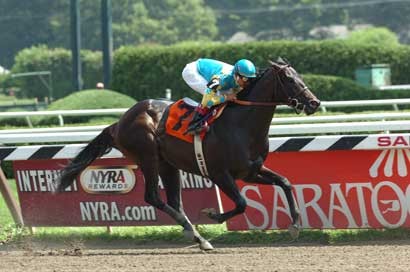State report: 'NYRA gambles with financial future'
Comptroller DiNapoli's audit indicates horse-racing association's failure to implement reforms after bankruptcy
An audit report released last week by state Comptroller Thomas DiNapoli suggests that the New York Racing Association — the state’s governing body of thoroughbred horse racing, which includes Belmont Park and the Aqueduct Racetrack — has been gambling on its financial future.
In 2006, NYRA filed for bankruptcy, seeking protection from creditors, and blamed the state’s too-slow approval of video lottery terminals at Aqueduct, which were initially authorized by the state in 2001 but were not installed until last October. According to NYRA, the VLTs were expected to bring in tens of millions of dollars in revenue.
Those estimates ultimately proved correct. Since opening on Oct. 28, Aqueduct’s Resorts World Casino-New York has brought in more than $90 million in revenue, according to the New York Lottery website.
According to the comptroller’s report, DiNapoli’s office discovered in December that NYRA was keeping a larger percentage of exotic wagering — multiple wagers such as Exactas and Trifectas — than it was permitted to, depriving bettors of their rightful winnings. NYRA failed to reduce the fee it charges bettors on Trifecta, Superfecta, Grand Slam, Pick 3, Pick 4 and Pick 6 wagers for 15 months, costing the public more than $8 million. According to NYRA, the association mistakenly overlooked a “takeout” decrease that was required by a provision of the Racing Law that expired in 2010, leading to the error.
That finding led the New York State Racing and Wagering Board to take action against NYRA, ordering the association to repay patrons who can be identified by March 30.
Additionally, according to DiNapoli’s report, NYRA has not conducted a top-to-bottom review of its financial operations and taken necessary steps to curb costs, particularly for staffing and consulting contracts — actions that were critically recommended by the state in two post-bankruptcy audits of the association.
In one audit, released by the state in July 2010, auditors found that NYRA waited for more than a year after it emerged from bankruptcy to begin operational reforms. Immediately after that report, DiNapoli initiated another audit to provide real-time monitoring of NYRA’s financial condition and operations, in order to determine whether it needed state revenue to continue operating. That audit was released in August 2010, and recommended that NYRA undertake cost-saving reforms and conduct random cash counts and other verification activities.
“More than a year after my office’s last audit and real-time financial monitoring of NYRA, the organization still has much work to do to carry out the reforms we recommended,” DiNapoli said. “NYRA stands to squander significant revenue from the recently opened VLT franchise at Aqueduct. I will continue to closely monitor NYRA to ensure it reins in unnecessary spending and does not waste the new money coming in from the Aqueduct racino.”
According to the recent audit, NYRA failed to prepare a staffing analysis, outlining the optimal number of employees in each of its departments, as auditors recommended, despite cutting its staff by 3 percent from 2009 to 2010, and failed to examine the cost-effectiveness of its contracts, despite ending a contract with its former integrity counsel and awarding a more cost-effective contract to a different counsel.
DiNapoli also wrote that despite saving nearly $92,000 by in-sourcing horse transportation, NYRA still needs to evaluate whether the transportation of horses between NYRA tracks at no cost to horse owners is necessary for it to remain competitive.
He added that without significant changes to its operations, NYRA would simply use the windfall from VLTs this year to mask ongoing financial problems and inefficiencies. According to the January audit, NYRA projected an $11.5 million deficit for 2011 and expects a $19.7 million loss from racing operations this year, and would show a profit this year only if it increased VLT revenue.
According to a statement released by NYRA last week, however, DiNapoli’s audit failed to take the association’s 2012 budget into consideration, which projects a net revenue increase of $48 million due to new gaming revenue, and nearly $19 million in net income. NYRA also wrote that operating income solely from current racing operations — with VLT revenue not included — is projected to be $1.4 million.
Dan Silver, a NYRA spokesman, said that the association receives around 7 percent of Aqueduct’s VLT proceeds, which are regulated by state statute. Three percent goes to NYRA’s operations, and 4 percent to capital expenditures, he explained.
“While no specific determinations have been made yet on how [capital expenditures] will be spent,” Silver said, “some of it will certainly be spent to improve Belmont Park.”
“NYRA conducts a rigorous annual budget review and approval process, and NYRA’s budget is reviewed by the New York State Franchise Oversight Board,” NYRA officials wrote last week. “Furthermore, NYRA’s financial results and internal controls are routinely audited. NYRA is committed to the highest standards of corporate governance, integrity and management.”
NYRA officials went on to say that while the association took the state’s previous audit recommendations seriously and has made strides to implement them, it did not have the money required to implement all of them in time for the recent audit. “NYRA has and will continue to maintain financial discipline,” NYRA officials wrote, adding, “We fully understand the importance of this process and remain committed to completing it.”
For a complete copy of the follow up report, go to: https://www.osc.state.ny.us/audits/allaudits/093012/11f16.pdf

 80.0°,
Partly Cloudy
80.0°,
Partly Cloudy 




